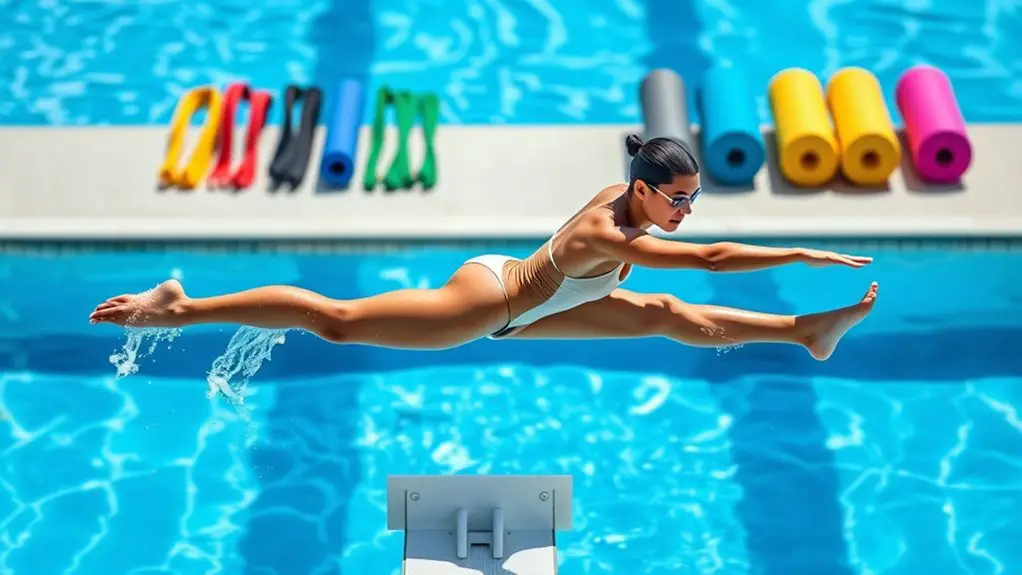To boost shoulder stability in swimming, incorporate resistance band exercises like external rotations and band pull-aparts, as well as bodyweight exercises, such as push-ups and planks. These moves target essential shoulder muscles and enhance stability, preventing injuries and improving performance. Don't forget to warm up with dynamic stretches and mobility drills like arm circles to prepare your shoulders for action. If you're interested, you can discover more targeted exercises and tips to perfect your dryland workout plan.
Understanding Shoulder Stability in Swimming
Shoulder stability is essential for swimmers, as it directly impacts performance and injury prevention. Understanding shoulder biomechanics is key to mastering swimming techniques. Your shoulders are constantly at work, rotating and extending with each stroke, so having a stable foundation is vital. When your shoulders are stable, you can move freely through the water, enhancing your efficiency and speed.
If your shoulder stability is compromised, it can lead to poor technique and increase the risk of injuries like rotator cuff tears. By focusing on the mechanics of your shoulder movements, you can improve your overall swim performance. Emphasizing proper alignment and engaging the right muscles will give you the freedom to enjoy the water without fear. Prioritizing shoulder stability not only boosts your swimming prowess but also keeps you in the pool longer, allowing you to pursue your passion without limits. A strong rotator cuff enables lifting, throwing, and daily tasks without limitation, further supporting your swimming performance.
The Importance of Dryland Training
Dryland training is essential for swimmers looking to enhance their performance. By focusing on muscle strength and joint mobility, you can greatly reduce your risk of injury. Incorporating these exercises into your routine will help you swim more efficiently and safely. Additionally, investing in shoulder workouts will lead to improved power and endurance in the water.
Enhances Muscle Strength
Building muscle strength is essential for swimmers looking to enhance their performance and prevent injuries. Dryland training focuses on developing muscle hypertrophy and strength endurance, which are vital for powerful strokes and sustained energy in the water. Without proper muscle strength, you risk fatigue and injury.
Here are three benefits of enhancing muscle strength through dryland exercises:
- Improved Performance: Stronger muscles directly contribute to better swimming efficiency and speed.
- Injury Prevention: Building strength helps stabilize the shoulder joints, reducing the likelihood of overuse injuries.
- Enhanced Recovery: Increased muscle endurance allows for quicker recovery between sets and workouts.
Improves Joint Mobility
While many swimmers focus solely on in-water training, improving joint mobility through targeted dryland exercises is essential for peak performance. Enhancing your joint flexibility can greatly impact your shoulder range, allowing you to achieve a more efficient stroke. By incorporating exercises like arm circles, resistance band stretches, and thoracic rotations, you'll not only increase mobility but also foster a sense of freedom in your movements. When your shoulders move with ease, you'll feel more confident and powerful in the water. This newfound mobility helps you swim more fluidly, making every stroke feel less constrained. Embracing dryland training is key to releasing your full potential and enjoying the liberating experience of swimming at your best.
Prevents Injury Risk
Injury prevention is essential for every swimmer aiming to maintain peak performance throughout the season. Implementing effective dryland training can help you strengthen your shoulders and reduce injury risk. Here are some key injury prevention strategies to contemplate:
- Incorporate rehabilitation exercises that target shoulder stability.
- Focus on developing core strength, which supports overall shoulder function.
- Use resistance bands and weights to build muscle endurance.
Key Muscles for Shoulder Stability
Shoulder stability is essential for swimmers, as it supports powerful strokes and helps prevent injury. To achieve this, you need to focus on key muscles, particularly the rotator cuff and muscles responsible for scapular stability. The rotator cuff, a group of four muscles, plays a critical role in shoulder movement and strength. When these muscles are strong and balanced, they provide the support necessary to execute strokes efficiently.
Additionally, the scapular stabilizers, including the serratus anterior and trapezius, help maintain proper shoulder alignment and movement. By prioritizing these muscle groups in your dryland training, you'll enhance your shoulder stability, allowing for greater freedom in the water. You'll find that improved stability not only boosts your performance but also reduces the risk of injury. Embrace exercises that target these areas, and your swimming experience will be more powerful and enjoyable. Incorporating rotator cuff exercises into your routine can significantly improve your shoulder strength and stability.
Warm-Up Exercises for Swimmers
Warming up is essential for preparing your body for swimming, helping to prevent injuries and improve performance. Incorporating dynamic stretching techniques and pre-swim activation drills can enhance your shoulder stability and overall mobility. These exercises not only prepare your muscles but also reduce the risk of injuries that can hinder your swimming routine. Let's explore how these warm-up exercises can make a difference in your swim routine.
Importance of Warm-Up
Before diving into the water, it is crucial to prepare your body with a proper warm-up, as this can greatly enhance your performance and reduce the risk of injury. A good warm-up not only boosts your energy but also emphasizes the importance of flexibility in your movements. Aim for a warm-up duration of at least 10-15 minutes to get your muscles primed for action.
- Increases blood flow to your muscles
- Prepares your joints for the demands of swimming
- Helps you mentally focus on your swim
Dynamic Stretching Techniques
Incorporating dynamic stretching techniques into your warm-up routine can greatly enhance your swimming performance. These dynamic warm ups are all about movement, promoting blood flow and preparing your muscles for action. Instead of static stretching, try movements like arm circles, torso twists, and leg swings. These flexibility exercises not only improve your range of motion but also activate the muscles you'll rely on in the pool. As you flow through these stretches, you'll feel your body loosen and your mind sharpen. Remember, the goal is to energize your muscles and joints, setting the stage for an effective swim. So, embrace these dynamic stretches and give yourself the freedom to move fluidly in the water!
Pre-Swim Activation Drills
Dynamic stretching sets a solid foundation for your swim, but pairing it with pre-swim activation drills can take your performance to the next level. These drills focus on shoulder activation, ensuring your muscles are primed for action. Here are three effective exercises to incorporate into your routine:
- Scapular Push-Ups: Engage your shoulder blades while stabilizing your core.
- Band Pull-Aparts: Strengthen your upper back and improve posture with resistance bands.
- Arm Circles: Loosen up your shoulders and enhance mobility with dynamic movements.
Resistance Band Exercises
While swimming relies heavily on the strength and stability of your shoulders, resistance band exercises can effectively enhance these qualities off the water. Incorporating band resistance techniques into your routine allows you to target key muscles without the constraints of traditional weights. Start with shoulder activation drills like external rotations or band pull-aparts to engage those important stabilizers.
As you progress, try lateral raises and front raises with the band, focusing on controlled movements to build strength and endurance. The beauty of resistance bands is their versatility; you can easily adjust the tension to suit your level. Plus, you can perform these exercises anywhere, giving you the freedom to train on your own terms. Remember, consistent practice not only improves your shoulder stability but also enhances your overall swimming performance. Additionally, developing strong posterior chain muscles through varied resistance exercises contributes significantly to overall strength and injury prevention. So grab a band, and let's get those shoulders ready for your next swim!
Stability Ball Workouts
Resistance band exercises are a great start, but adding stability ball workouts can take your shoulder stability to another level. These exercises not only enhance your shoulder strength but also engage your core, giving you that freedom of movement you crave in the water.
Boost your shoulder stability and core strength with stability ball workouts for improved performance in the water.
Here are some stability ball benefits you'll love:
- Improved Balance: Working on the ball challenges your stability, helping you stay grounded while swimming.
- Enhanced Core Engagement: Your core gets a serious workout, which is essential for maintaining proper body position in the water.
- Increased Shoulder Mobility: Stability ball exercises promote a greater range of motion, allowing for more fluid strokes.
Incorporating stability ball workouts into your routine can help you achieve the shoulder stability you need to dominate your next swim. Mobility training is essential for enhancing overall performance, so grab that ball and let's get started on your journey to better performance!
Bodyweight Exercises for Shoulder Strength
When it comes to building shoulder strength, bodyweight exercises are a fantastic option that requires no equipment and can be done anywhere. You can easily incorporate bodyweight variations into your routine, making it both flexible and fun. Push-ups, planks, and handstand holds are excellent moves that target your shoulders effectively.
To keep progressing, focus on progressive overload. This means increasing the difficulty of your exercises over time, whether by adding more reps, changing angles, or exploring advanced variations like one-arm push-ups. Engaging in these exercises not only builds strength but also enhances stability, essential for your swimming performance. A strong core reduces injury risk by supporting the spine during exertion, which is vital for swimmers.
Whether you're at home, at the park, or on vacation, these bodyweight exercises empower you to strengthen your shoulders without constraints. So go ahead, embrace the freedom of bodyweight training, and watch your shoulder stability flourish!
Weight Training for Swimmers
Incorporating weight training into your routine can considerably enhance your swimming performance by building strength and power in your shoulders. By engaging in strength training and resistance training, you'll not only boost your shoulder stability but also improve your overall swimming efficiency. Here are a few key benefits to take into account:
- Increased Muscle Endurance: Weight training enhances your muscles' ability to sustain prolonged activity, which is vital for long swims.
- Enhanced Power: Building strength translates into more powerful strokes and faster times.
- Reduced Injury Risk: Strengthening your shoulders helps prevent common swimming injuries, allowing you to train consistently. Additionally, developing muscular endurance is crucial for sustaining high performance throughout your swimming events.
Incorporating Mobility Drills
Building strength through weight training is just one piece of the puzzle for improving shoulder stability in swimmers. To truly enhance your performance, you need to incorporate mobility drills that emphasize dynamic mobility and functional movement. These drills not only prepare your shoulders for the demands of swimming but also promote greater range of motion and fluidity in your strokes.
Start with exercises like arm circles and shoulder dislocates using a resistance band. These movements will help your shoulders warm up and engage the necessary muscle groups. You might also consider incorporating thoracic spine rotations to guarantee your upper body moves freely and efficiently during swims.
Designing Your Dryland Workout Plan
To create an effective dryland workout plan, you should first assess your current strength levels. Once you know where you stand, incorporate specific movements that target shoulder stability. Finally, establishing a consistent schedule will help you stay on track and see improvements over time.
Assess Your Current Strength
Before diving into a dryland workout plan, it's crucial to assess your current strength to tailor your exercises effectively. A strength assessment helps you understand where you stand and what you need to improve for peak performance. Here's how to get started:
- Identify weak points: Focus on areas that feel less stable or strong during your swim strokes.
- Track your progress: Regular performance evaluations allow you to see improvements and adjust your plan accordingly.
- Set realistic goals: Establish achievable targets based on your assessment to keep you motivated and on track.
Incorporate Specific Movements
Having assessed your current strength, the next step is to incorporate specific movements into your dryland workout plan. Focus on shoulder rotations to enhance your range of motion and build strength. These rotations can be done with resistance bands or light weights to guarantee you're challenging your muscles without overdoing it.
In addition to shoulder rotations, stability drills are essential for maintaining control during your strokes. Exercises like plank shoulder taps or stability ball push-ups will engage your core while reinforcing shoulder stability.
Establish a Consistent Schedule
While designing your dryland workout plan, establishing a consistent schedule is essential for effective training. A well-structured routine not only boosts your shoulder stability but also gives you the freedom to manage your time wisely. Here are some tips to help you stay on track:
- Set realistic goals: Break down your larger objectives into achievable milestones.
- Block out time: Schedule specific days and times dedicated to your workouts, just like you would for swim practices.
- Stay flexible: Life happens! Allow for adjustments but keep your commitment to consistency.
Frequently Asked Questions
How Often Should I Perform Dryland Exercises for Shoulder Stability?
To boost your shoulder stability, aim for dryland exercises about two to three times a week. This frequency recommendation helps you maintain training consistency while allowing your body to recover. Listen to your body, and don't hesitate to adjust based on how you're feeling. Embrace the freedom to customize your routine; after all, it's all about finding what works best for you while still challenging those shoulders!
Can Dryland Training Help Prevent Shoulder Injuries in Swimmers?
Oh sure, just swim without any training and hope for the best, right? But seriously, dryland training can greatly aid in injury prevention. By strengthening your shoulders, you're not just building muscles; you're giving yourself the freedom to swim with confidence. The training benefits extend beyond just performance, helping you avoid those nagging injuries that can sideline you. So, embrace those workouts, and your shoulders will thank you later!
What Age Can Swimmers Start Dryland Training for Shoulder Stability?
You can start youth training for shoulder stability around the ages of 12 to 14, but age considerations are essential. It's important to guarantee that the swimmer has developed enough strength and coordination before diving into dryland exercises. By this age, they're usually ready to incorporate basic stability drills, helping them build a strong foundation while keeping the experience fun and engaging. Always prioritize proper technique to avoid injuries down the line.
Should I Focus More on Strength or Flexibility for Shoulder Stability?
Imagine you're a swimmer aiming to improve your shoulder stability. You might wonder if you should prioritize strength training or flexibility exercises. Ideally, it's a balance of both. Strength training builds the muscles around your shoulders, while flexibility exercises enhance your range of motion. For instance, incorporating resistance bands can boost strength, while dynamic stretches can keep you limber. By focusing on both, you'll achieve the freedom to swim more efficiently and confidently.
How Do I Know if My Shoulder Stability Is Improving?
To know if your shoulder stability's improving, you can perform regular shoulder assessments. Keep track of your progress against stability benchmarks like range of motion, strength levels, and pain-free movements. If you notice increased control and less discomfort during activities, that's a good sign. Remember, it's all about feeling free in your movements, so listen to your body and stay consistent with your evaluations to see real improvements over time.




